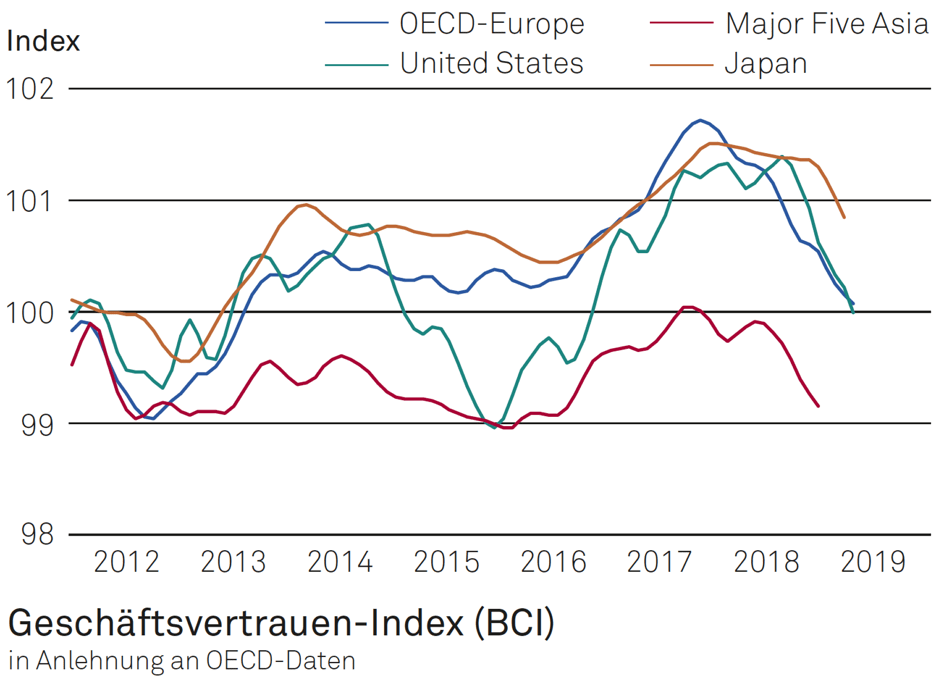hpo Spotlight
Are you prepared for the economic downturn?
The signs of an upcoming economic downturn are intensifying, leading to increased uncertainty. This is why company leaders are well-advised to check their structures and processes for their suitability in difficult economic times. The top priority is to make the company more efficient and scalable. But how?
Share article

Signs of an imminent economic downturn are mounting
According to hpo forecasting, four reasons speak for an imminent economic crisis:
- According to our analyses, the consumer and industrial cycles have, as expected, reached or already clearly exceeded their peaks in all major economic regions. As Peter Meier pointed out in an NZZ article more than a year ago, this is a reliable indicator of an impending economic crisis, which only occurs every 7 to 12 years. With the Peter Meier forecasting model, hpo forecasting was able to date and forecast the looming crisis quite reliably already about two years ago.
- In almost all capital goods industries we have seen falling order intake figures since the beginning of the year, but mostly still at a relatively high level. In early-cycle industries such as semiconductors, order intake has already fallen sharply. In the last three quarters, global demand for semiconductors has already shrunk by around 20% - the sharpest decline since the crisis year 2008.
- We observed a sharp decline in business confidence in the past quarter in Europe, the USA as well as in Asia (cf. chart). In the past, such a synchronised and strong decline in business confidence was usually only observed before major economic crises. In the USA and Europe, the BCI already fell below the 100 level in the second quarter and is now clearly below it. Values below 100 indicate a negative outlook. The corresponding aggregate value for Asia has been at a low level for some time.

- The American yield curve, much discussed in the economic press, has flattened considerably and has been in negative territory since May 2019 (view: government bonds with a maturity of 10 years vs. 3 months). In the past, an inverse yield curve has announced economic crises with a high degree of reliability.
In our opinion, the fact that the financial markets have not yet come under greater pressure has a lot to do with the monetary policy of the central banks and little to do with the real economy. How long can the financial markets withstand the pressure of the real economy?
Conclusion
Companies that are heavily exposed to the economic downturn must prepare themselves for a prolonged downturn. This mainly affects sectors such as mechanical engineering. As the economy weakens, the risk of various bubbles bursting in the financial market, which have their roots in the extremely expansive central bank policy of the last ten years, also increases. The risk of a new financial crisis increases, and this would then also have negative effects on almost all other sectors.
Challenges with changes in the economy
When the economy changes, the central challenge for every company remains to maintain its performance. In this context, the company's result and the preservation of the company's value are in the foreground. Every upswing or downswing causes the company to deviate from its optimal performance, i.e. from the optimal operating point. The operating point is the point at which the relationship between output and input is in the best possible ratio. As soon as companies are outside a tolerance band of +/-10% above or below this operating point, it leads to a change in performance. In our projects we have found that a slight overload has a better effect on performance than a slight underload.
Consequences of an economic downturn
During an economic downturn, a company very often deviates from the optimal operating point. This means that deviations from the plan quickly occur, which usually have drastic consequences for the company's overall results. The main reason for this is relatively simple: companies are usually not designed to respond to volatility in a sustainable way. The reasons for not being designed for volatility are complex. It can mostly be equated with a "systemic failure". In the long run, companies that are good at dealing with volatility have an advantage. But this also means that a company has to question itself in its actions and be open to new ways of doing things. One way to prepare for economic fluctuations is strategic organisational design.
Strengthening performance and resilience with holistic enterprise design
Strategic organisational design ensures that a company can achieve its full performance, both at the planned operating point (measurable point for optimal performance) and in the event of deviations from the planned operating point caused by fluctuations in the economy. In a strategically designed company, the system, i.e. employees and processes, can adapt more quickly to the new situation.
Strategic organisational design is holistic. It ensures that the following elements are aligned and positively influence performance:
- Value creation: If the service provided by the company is clearly aligned and differentiating, the entrepreneurial risk can be reduced.
- Core competencies: The development of own differentiating capabilities and the decision to make or buy (i.e. to produce or purchase services) guarantees a focus.
- Business processes: The processes defined to deliver value are aggregated, consolidated and aligned in a higher-level business process model.
- Cost structures: A flexible cost control system that quickly measures the change in the ratio of variable to fixed costs enables a rapid response in case of deviation.
- Agility: The permanent staffing of success-critical vessels (e.g. trend identification and assessment) as opposed to an annual survey ensures predictability and rapid reaction in the event of changes.
Overall, strategic enterprise design makes companies more adaptable and resilient, ensuring that they can perform at their best at all times.
More publications

The optimal Operating Point

Scalable Organisation

High Performance through holistic organisation design

Your strategy and organisation consultancy
Who is hpo management consulting?
hpo stands for High Performance Organisations. As experts for strategy, business processes, organisation and transformation, we have been supporting nationally and globally active clients since 1995 in releasing performance potential and transforming strategies into measurable results. With our holistic and partnership-based enterprise desing approach, we reliably lead them to their goal: a consistently designed and sustainably effective High Performance Organisation - fit for the future and with a clear competitive advantage.
hpo - unlocking performance